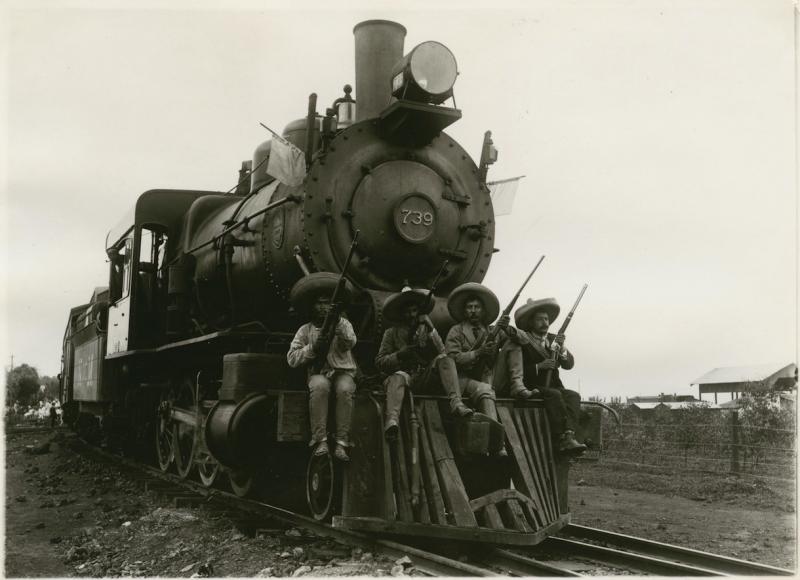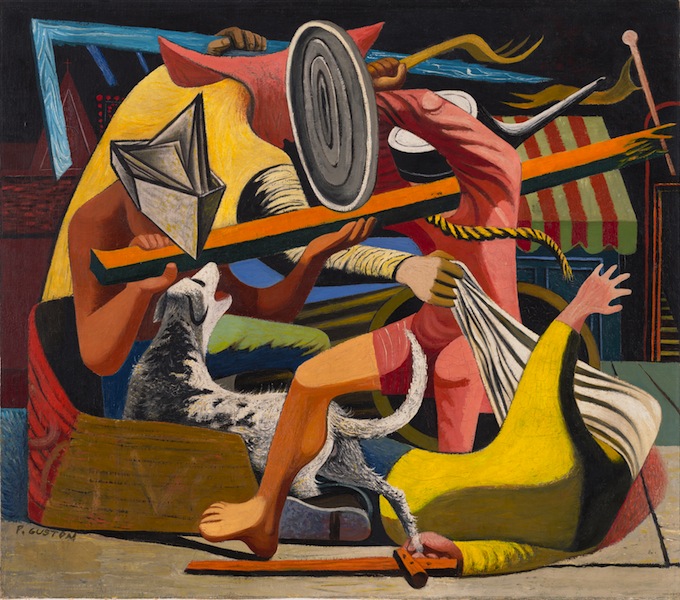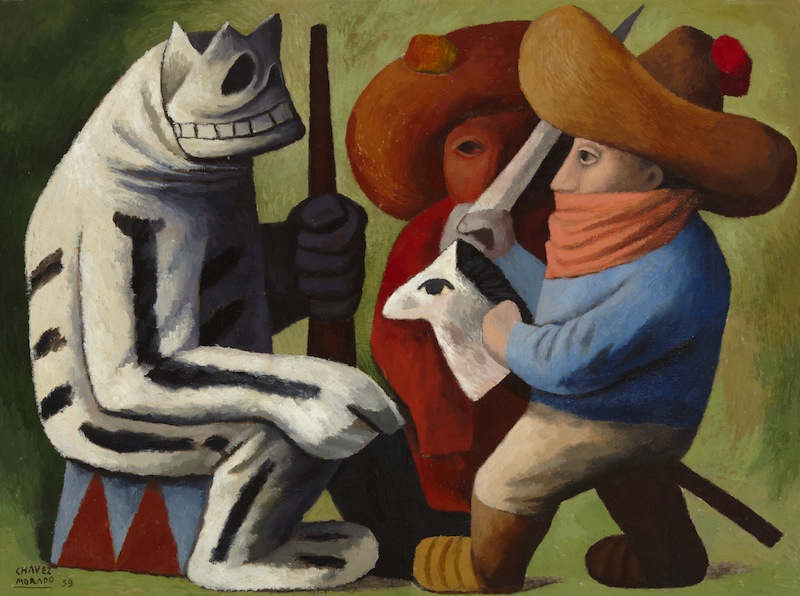Mexico: A Revolution in Art 1910-1940, Royal Academy | reviews, news & interviews
Mexico: A Revolution in Art 1910-1940, Royal Academy
Mexico: A Revolution in Art 1910-1940, Royal Academy
An incisive exploration of an artistic renaissance in the midst of a brutal revolution

Artists love a good revolution. The social upheaval, the bubbling up of new ideas and the breaking down of old ones, attracts them like flies to fly paper. The Mexican revolution was no exception. During the years 1910-1940, Mexico attracted large numbers of international intellectuals and artists, seduced by the political maelstrom and apparent freedoms that beckoned in this culturally diverse and varied land.
For many European artists Mexico seemed like a primitive (if somewhat fictional) Nirvana, with its stunning scenery, indigenous culture and mysticism that fed the modernist appetite for authenticity and new experiences. Anyone who was anyone wanted to be part of the action. Josef Albers, Edward Burra, Philip Guston (pictured below right: Gladiators, 1940; Museum of Modern Art, New York), and the photographers Cartier-Bresson, Tina Modotti, Edward Weston and Paul Strand, along with writers such as Somerset Maugham and D. H. Lawrence, all came to feed at this table of violence and exotic otherness, alongside native Mexican born artists, in an unabashed display of cultural appropriation. “How beautiful the revolution is, even in its savagery,” chirped the Mexican writer, Mariano Azuela.
Many fine photographs reveal the extent of death and destruction that beset the country
The beginning of the 20th century was an era of political ferment. The Russian Revolution and the Spanish Civil War saw the rise of the masses against the privileged few. The 1910 outbreak of the Mexican Revolution brought to an end the 26-year reign of Porfirio Diaz, known as the "Porfiriato", during which a small landowning class dominated the country both economically and politically, living a luxurious lifestyle that imitated the Belle Époque in France and the East Coast of the United States. That year Halley’s Comet was clearly visible in the Mexican skies. Taken as an auspicious sign, it was later seen, as it had been in 1517 by the Mexica (Aztecs) with the arrival of Hernán Cortés and his plundering Spanish conquistadores, as a portent of violent change.
Mexico: A Revolution in Art, 1910-1940 examines how the Revolution shaped not only contemporary Mexico but brought it in from the cultural peripheries to place it centre-stage within the modernist debate.
 The Mexican Revolution was, in fact, many things. Brutal and fragmented, it nonetheless brought about an artistic renaissance within the country. This was largely made possible by the technical advances in film and photography that allowed the disasters of war to be laid bare in visceral-style of reportage. That the Revolution received more news coverage than any conflict before the Second World War was, no doubt, in part due to the fear of invasion from the neighbouring Americans, who displayed an insatiable, and perhaps anxious, appetite for news. The "most famous bandit-rebel of the Revolution", Francisco "Pancho" Villa - with his cartoon sombrero, bullet belts and Zapata moustache - even struck a highly advantageous financial deal with the Mutual Film Corporation to fight battles during the day, so that they could be caught on camera.
The Mexican Revolution was, in fact, many things. Brutal and fragmented, it nonetheless brought about an artistic renaissance within the country. This was largely made possible by the technical advances in film and photography that allowed the disasters of war to be laid bare in visceral-style of reportage. That the Revolution received more news coverage than any conflict before the Second World War was, no doubt, in part due to the fear of invasion from the neighbouring Americans, who displayed an insatiable, and perhaps anxious, appetite for news. The "most famous bandit-rebel of the Revolution", Francisco "Pancho" Villa - with his cartoon sombrero, bullet belts and Zapata moustache - even struck a highly advantageous financial deal with the Mutual Film Corporation to fight battles during the day, so that they could be caught on camera.
This exhibition has many fine photographs that reveal the extent of death and destruction that beset the country. The newspaper office in Mexico City, a banner declaring El Heraldo Independiente draped across the peppering of bullet holes and broken windows and the smashed apartments of the rich with their shattered chandeliers, captured in sepia-tones by Manuel Ramos, show the wide-ranging damage.
 Although the Revolution’s aspirations may have originally been idealistic, the day-to -day reality was very different. Summary executions by hanging and firing squad and piles of battle-dead were recorded by the American Walter Horne. Seeing the chance of a business opportunity, he was to establish the Mexican War Photo Postcard Company for those hungry to see events first hand. Meanwhile, the iconic (and posed) photograph of the notorious Emiliano Zapata, by the German-born Hugo Brehme, was turned into an engraving by José Guadalupe Posada to illustrate cheap broadsheets for the mass market. Pofriro Diaz hadn’t much liked photography. It was too real and too gritty and he had insisted only on images that showed the Mexican people in a positive light. But for the revolutionaries photography was a way to show the world what they were suffering. (Pictured above left: Jose Chavez Morado, Carnival in Huejotzingo, 1939; Phoenix Art Museum.)
Although the Revolution’s aspirations may have originally been idealistic, the day-to -day reality was very different. Summary executions by hanging and firing squad and piles of battle-dead were recorded by the American Walter Horne. Seeing the chance of a business opportunity, he was to establish the Mexican War Photo Postcard Company for those hungry to see events first hand. Meanwhile, the iconic (and posed) photograph of the notorious Emiliano Zapata, by the German-born Hugo Brehme, was turned into an engraving by José Guadalupe Posada to illustrate cheap broadsheets for the mass market. Pofriro Diaz hadn’t much liked photography. It was too real and too gritty and he had insisted only on images that showed the Mexican people in a positive light. But for the revolutionaries photography was a way to show the world what they were suffering. (Pictured above left: Jose Chavez Morado, Carnival in Huejotzingo, 1939; Phoenix Art Museum.)
Most Mexicans were illiterate and the Catholic Church had traditionally used murals as an educative tool. The newly formed revolutionary government needed ways to promote their ideals and took a leaf from Church’s book and in 1920 sent Diego Rivera to look at Italian frescos. On his return he was commissioned to paint murals that told the story of Mexico through the eyes of its indigenous people. This did much to reinstate the mural as a valid modernist form. Rivera, José Clemente Orozco, along with his rival, the painter David Alfaro Siqueiros were to became known as los tres grandes, though their brand of proselytizing public works were not to everyone’s taste. It's interesting that in these less politically committed, more narcissistic, times their names have been somewhat eclipsed by the solipsistic works of Diego’s wife, Frida Kahlo, so it’s strange that she is so under represented here, with only one miniature self-portrait.
The years between 1910-1940 were extraordinary times, attracting extraordinary people from around the world, from Leon Tolstoy to André Breton, from Graham Green to Evelyn Waugh, each seeking his or her own "version" of Mexico. It is hard to imagine a war ever having that cultural pull again. But this unique matrix of indigenous and European, modern, pre-Columbian and Catholic art was, as this incisive exhibition shows, to have a lasting impact on the imagery of the 20th century.
- Mexico: A Revolution in Art 1910-40 at the Royal Academy from 6 July until 29 September
Explore topics
Share this article
The future of Arts Journalism
You can stop theartsdesk.com closing!
We urgently need financing to survive. Our fundraising drive has thus far raised £33,000 but we need to reach £100,000 or we will be forced to close. Please contribute here: https://gofund.me/c3f6033d
And if you can forward this information to anyone who might assist, we’d be grateful.

Subscribe to theartsdesk.com
Thank you for continuing to read our work on theartsdesk.com. For unlimited access to every article in its entirety, including our archive of more than 15,000 pieces, we're asking for £5 per month or £40 per year. We feel it's a very good deal, and hope you do too.
To take a subscription now simply click here.
And if you're looking for that extra gift for a friend or family member, why not treat them to a theartsdesk.com gift subscription?
more Visual arts
 Help to give theartsdesk a future!
Support our GoFundMe appeal
Help to give theartsdesk a future!
Support our GoFundMe appeal
 Echoes: Stone Circles, Community and Heritage, Stonehenge Visitor Centre review - young photographers explore ancient resonances
The ancient monument opens its first exhibition of new photography
Echoes: Stone Circles, Community and Heritage, Stonehenge Visitor Centre review - young photographers explore ancient resonances
The ancient monument opens its first exhibition of new photography
 Hylozoic/Desires: Salt Cosmologies, Somerset House and The Hedge of Halomancy, Tate Britain review - the power of white powder
A strong message diluted by space and time
Hylozoic/Desires: Salt Cosmologies, Somerset House and The Hedge of Halomancy, Tate Britain review - the power of white powder
A strong message diluted by space and time
 Mickalene Thomas, All About Love, Hayward Gallery review - all that glitters
The shock of the glue: rhinestones to the ready
Mickalene Thomas, All About Love, Hayward Gallery review - all that glitters
The shock of the glue: rhinestones to the ready
 Interview: Polar photographer Sebastian Copeland talks about the dramatic changes in the Arctic
An ominous shift has come with dark patches appearing on the Greenland ice sheet
Interview: Polar photographer Sebastian Copeland talks about the dramatic changes in the Arctic
An ominous shift has come with dark patches appearing on the Greenland ice sheet
 Donald Rodney: Visceral Canker, Whitechapel Gallery review - absence made powerfully present
Illness as a drive to creativity
Donald Rodney: Visceral Canker, Whitechapel Gallery review - absence made powerfully present
Illness as a drive to creativity
 Noah Davis, Barbican review - the ordinary made strangely compelling
A voice from the margins
Noah Davis, Barbican review - the ordinary made strangely compelling
A voice from the margins
 Best of 2024: Visual Arts
A great year for women artists
Best of 2024: Visual Arts
A great year for women artists
 Electric Dreams: Art and Technology Before the Internet, Tate Modern review - an exhaustive and exhausting show
Flashing lights, beeps and buzzes are diverting, but quickly pall
Electric Dreams: Art and Technology Before the Internet, Tate Modern review - an exhaustive and exhausting show
Flashing lights, beeps and buzzes are diverting, but quickly pall
 ARK: United States V by Laurie Anderson, Aviva Studios, Manchester review - a vessel for the thoughts and imaginings of a lifetime
Despite anticipating disaster, this mesmerising voyage is full of hope
ARK: United States V by Laurie Anderson, Aviva Studios, Manchester review - a vessel for the thoughts and imaginings of a lifetime
Despite anticipating disaster, this mesmerising voyage is full of hope
 Lygia Clark: The I and the You, Sonia Boyce: An Awkward Relation, Whitechapel Gallery review - breaking boundaries
Two artists, 50 years apart, invite audience participation
Lygia Clark: The I and the You, Sonia Boyce: An Awkward Relation, Whitechapel Gallery review - breaking boundaries
Two artists, 50 years apart, invite audience participation

Add comment